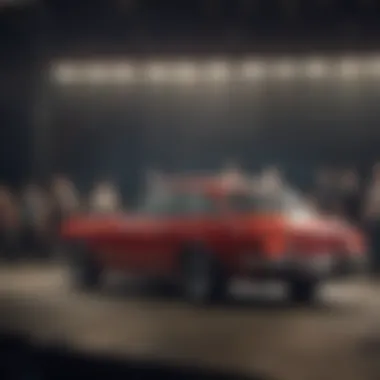The Rolling Stones on Tour: A Comprehensive Exploration


Intro
The Rolling Stones have long been synonymous with live music. Their tours are not just performances but significant cultural events that shape the landscape of the music industry. From their early days in the 1960s to their more recent shows, the band's approach to touring has evolved, mirroring broader changes in society and technology.
This exploration aims to uncover the various facets of The Rolling Stones on tour, highlighting how they have remained at the forefront of live performances for decades.
Key elements discussed include their distinctive live style, technological innovations in their shows, and how audience engagement strategies have transformed over time. Additionally, the historical significance of major tours and their contributions to popular music culture will be examined. Through a detailed analysis, readers will gain a comprehensive understanding of how The Rolling Stones have crafted their legacy through the art of touring.
Historical Context of The Rolling Stones Tours
Understanding the historical context of The Rolling Stones' tours is critical in appreciating their evolution in live music. This section lays the groundwork for discussing the band's journey, revealing how their early days set the stage for what would become monumental events in music history. The connection between the band's formation and the cultural landscape of the time informs many aspects of their tours. It also highlights the innovations and setbacks faced along the way.
Formation and Early Tours
The Rolling Stones formed in 1962. Their signature sound combined rhythm and blues with rock, captivating a generation. The initial lineup included Mick Jagger, Keith Richards, Brian Jones, Bill Wyman, and Charlie Watts. Early performances focused on small venues, giving the band a chance to refine their stage presence. During these early tours, they built a loyal fanbase, which contributed to their growing popularity. The intimacy of these initial venues contrasted sharply with the massive crowds they would later encounter, acting as a foundational experience that shaped their approach to live performances.
The 1960s: The Birth of a Live Phenomenon
The 1960s marked a turning point for The Rolling Stones as they emerged as a leading force in live music. Their concert at Hyde Park in 1969, attended by around 250,000 fans, showcased their immense popularity and solidified their status as a phenomenon. This era was characterized by significant social upheaval, and the Stones' music resonated with the desires of a disillusioned youth. Their performance style reflected the changing cultural attitudes, making each concert a unique experience infused with the spirit of the times.
Their tours throughout the 1960s also witnessed the introduction of extensive lighting and sound systems, marking a shift in how live music was produced and perceived. As they continued to innovate, the Stones helped lay the groundwork for modern rock concerts.
Iconic Festivals and Cultural Milestones
The Rolling Stones were not just performers; they became part of significant cultural milestones. Their performance at the Monterey Pop Festival in 1967 was pivotal, as it introduced them to a wider audience in the U.S. They headlined more festivals throughout the late 1960s and 1970s, including an unforgettable set at Woodstock.
These festivals provided more than just a platform for the band; they themselves became cultural events that echoed the spirit of revolution against the norm. Attending these festivals offered fans a collective experience that strengthened their identities as part of a larger movement.
"The Rolling Stones did not merely perform at festivals; they became a voice for a generation seeking change and authenticity."
Their connection to iconic events made each tour a representation of their ongoing impact on society and culture. The Rolling Stones transformed touring into an art, seamlessly blending music with the cultural zeitgeist.
Evolution of Live Performance Style
The evolution of live performance style for The Rolling Stones marks a significant chapter in the narrative of rock music. As the band has progressed from its early days to become icons of the genre, their approach to live shows has transformed dramatically. This transformation involves different aspects, including musical style, stage presence, and the integration of technology. Understanding this evolution helps to appreciate how they have maintained their relevance and captivated audiences across generations.
From Rhythm and Blues to Rock Icons
The Rolling Stones initially emerged in the 1960s as a band heavily influenced by rhythm and blues. Their early tours reflected this authenticity, showcasing covers of songs from notable artists like Chuck Berry and Muddy Waters. As they gained momentum, the band began to create original music, which combined the raw energy of rhythm and blues with rock elements. This shift is evident in their live performances, where they progressively incorporated more original works.
The significance of this evolution lies in the band’s ability to adapt. They transformed their sound and style to not only resonate with wider audiences but also to establish themselves as rock icons. Their tours during the late 1960s and into the 1970s became showcases for their evolving artistry, demonstrating how live performances could be an extension of their creative journey.
Stage Presence and Performance Dynamics
Stage presence is a core component of The Rolling Stones' live performance style. Mick Jagger’s charisma, combined with Keith Richards’ dynamic guitar work, creates an electrifying atmosphere. Over the years, their interactions with the audience have also evolved. Originally, the band performed mainly focused on delivering their music, but they gradually became more engaging. Jagger's movements and theatrics, along with humorous exchanges, foster a sense of connection with fans.
This stark evolution in performance dynamics is crucial for understanding their impact on live music. Their ability to read the crowd and adapt accordingly reinforces the idea that live performance is a collaborative experience. Each concert becomes unique, with the band reacting to the audience’s energy, thus making every show memorable. Jagger's iconic dance routines and various poses have set precedents for what a rock star’s stage persona should embody.
Incorporating Visual Elements
Technology has played an essential role in shaping The Rolling Stones’ live performances. The band has not only focused on musicality but also on the visual spectacle of their shows. Over the decades, they introduced elaborate light shows, intricate stage designs, and advanced audiovisual technology. These elements complement their music and provide a holistic entertainment experience.
The incorporation of visual elements enhances audience engagement and creates an immersive environment. This transformation reflects broader trends in the music industry, where visual presentation became almost as important as the music itself.


"Visual spectacle in a concert enhances the overall experience, making it more than just a musical event. It immerses the audience in the band’s artistry."
As they look forward, The Rolling Stones continue to push the boundaries of live performance. They have embraced the latest technologies while staying true to their roots, demonstrating that evolution does not mean abandoning what made them great in the first place.
Touring Logistics and Challenges
Touring not only signifies the heart of The Rolling Stones' career but also involves a complex framework that ensures each performance is executed flawlessly. This section examines the crucial aspects of touring logistics and the challenges faced by the band.
Planning and Coordination
Planning a tour requires meticulous attention to detail. The Rolling Stones engage a dedicated team to handle logistics, including scheduling, routing, and venue selections. Each phase requires careful coordination among various stakeholders.
For instance, selecting the venues is paramount. The band typically chooses locations that have historical significance or a strong connection to their fan base. The availability of adequate facilities for staging also plays a critical role. Transport logistics require coordination of equipment, crew, and band members across different time zones, often presenting unforeseen challenges.
- Routing is also important. The team must ensure that travel paths are efficient, minimizing both time on the road and costs.
- Timing is essential for sound checks and rehearsals before each concert. Each city has its unique regulations concerning noise and public space, which can complicate logistics.
The careful planning of logistics ensures that The Rolling Stones deliver high-quality performances night after night, maintaining their reputation as one of the most reliable live acts in history.
Health and Safety Considerations
Health and safety have become increasingly vital in the world of live music, especially following the global pandemic. The Rolling Stones have made significant adjustments to their touring practices to prioritize the well-being of their crew and fans.
Precautionary measures now include:
- Regular health screenings for both the band and crew members.
- Implementing safety protocols at venues, such as crowd control and contactless entry.
This shift not only ensures compliance with local regulations but also fosters trust among their audience. Fans can enjoy their performances with peace of mind, knowing that safety comes first.
Environmental and Sustainability Practices
The awareness concerning environmental issues has prompted The Rolling Stones to reevaluate their touring protocols. They now consider sustainability practices in their logistics significantly.
Key initiatives include:
- Reducing waste: Implementing recycling programs at venues and minimizing single-use plastics.
- Energy-efficient setups: Utilizing LED lighting and other eco-friendly technologies to reduce carbon footprint.
- Carbon offset: Engaging in practices to offset the emissions generated during tours, such as tree planting measures.
These efforts not only reflect a growing concern for the planet but also resonate with a fan base that increasingly values sustainability.
Technological Advancements in Touring
The evolution of technology has significantly transformed the landscape of concert experiences. For The Rolling Stones, this change has allowed the band to enhance their live performances and connect with audiences in ways that were previously unimaginable. Technological advancements are not just tools; they shape the essence of how music is experienced during tours. They provide new avenues for creativity while streamlining logistics. This section will delve into three key areas of technological innovation: sound and lighting, streaming and virtual concerts, and the integration of social media for promotion.
Sound and Lighting Innovations
Sound and lighting technology have revolutionized live performances. High-quality audio equipment ensures that each note resonates perfectly, regardless of the venue size. For The Rolling Stones, this is not only about clarity but also about creating an atmosphere that complements their music. The use of digital mixing consoles allows for real-time sound adjustments, making every performance dynamic.
Light configurations have also advanced. Advanced LED lighting systems enable colorful and intricate light displays that respond to the music in real-time. This visual stimulation enhances engagement with the audience.
Some specific innovations include:
- Line arrays for clearer sound distribution across the venue.
- Automated lighting systems that create dramatic effects and highlight band members.
This focus on technology allows The Rolling Stones to elevate their concerts from simple performances to captivating events.
Streaming and Virtual Concerts


The rise of the internet has brought about alternative methods for experiencing live music. Streaming and virtual concerts became necessary during global disruptions and have maintained relevance. This format changes how fans enjoy live music, ensuring that those unable to attend in person still feel part of the experience.
For The Rolling Stones, embracing this technology was strategic. They conducted successful live streams that attracted viewers from around the world. These events allow fans to enjoy high-quality performances, often augmented with behind-the-scenes content, which adds to their understanding of the band and its music.
Moreover, the ability to sell tickets for virtual events creates a new revenue stream. It broadens the audience base, as physical location no longer limits attendance.
Integration of Social Media for Promotion
Social media has become a critical tool for promoting tours and engaging audiences. The Rolling Stones utilize platforms like Facebook, Instagram, and Twitter to connect with fans directly. This relationship is crucial in today's entertainment landscape. Fans seek more than just music; they want to feel part of a community.
Using social media, The Rolling Stones can:
- Share real-time updates about tours and setlists.
- Use targeted ads to reach potential concert-goers.
- Engage with fans through live Q&As or sneak peeks of upcoming projects.
The integration of social media not only helps boost their visibility but also allows for immediate fan feedback, which can inform future performances.
"Technology in touring is not just about equipment. It’s about creating a connection, an experience that resonates with who we are as artists and with our audience." – Unknown
Audience Engagement and Interaction
The connection between The Rolling Stones and their audience is significant and multifaceted. Engaging fans throughout the years not only reinforces their status as a legendary band but also creates a community among diverse groups of listeners. As the band evolved, so did their strategies to interact with the fan base. These interactions are vital in shaping the concert experience and enhancing the overall value of attending live shows.
Fan Base Evolution and Diversity
The Rolling Stones have witnessed considerable changes in their fan base since their formation in the 1960s. Initially, their audience was primarily composed of young rock and roll enthusiasts. Over time, as music genres expanded, so too did the band's appeal. Today, they attract a diverse demographic that includes older generations who grew up with their music and younger fans drawn to the band's influence on contemporary music. This diversity enriches the concert atmosphere, leading to a vibrant tapestry of ages and backgrounds.
The band has embraced this evolution by altering their promotional approaches. They utilize social media to engage younger fans, encouraging them to participate in tours and events. This diversification in audience also reflects in the setlists, which now include a mix of classic hits and newer arrangements that resonate with modern music tastes.
Exploring Setlists: Changes Over Time
Setlists are crucial in defining the concert experience for fans. The Rolling Stones have continually adapted their setlists to balance fan favorites with newer tracks. Over the years, they have experimented with different combinations, showcasing their extensive catalog while keeping performances fresh. Fans often anticipate certain songs, creating an atmosphere of shared experience.
The band tends to include popular tracks like "Satisfaction" and "Paint It Black" while also introducing lesser-known songs or newer releases. This strategy not only satisfies long-time fans but also piques the interest of newer listeners.
Moreover, special performances can feature unique setlists tailored to specific venues or occasions. This adaptability enhances audience satisfaction and provides an engaging element for repeat attendees. The ongoing change in setlists underlines The Rolling Stones' commitment to keeping their live performances dynamic and relevant.
Meet-and-Greets and Backstage Access
In recent years, The Rolling Stones have recognized the value of providing fans with unique opportunities for engagement, such as meet-and-greets and backstage access. These experiences offer an insider's view of the tour and create lasting memories for fans. They allow for personal interactions with band members, which elevate the whole concert experience.
Meet-and-greet packages often include perks like exclusive merchandise and premium seating. The intimacy of these encounters can deepen the fan's connection to the band, buoying their loyalty. However, the demand for these experiences can lead to challenges in accessibility. Balancing exclusive fan engagement while maintaining a wide-reaching audience experience is a delicate task for the band.
Overall, audience engagement and interaction play an essential role in The Rolling Stones' tours. Their strategies have evolved alongside the band, reflecting changes in society and technology. Engaging with a diverse fan base and offering personalized experiences strengthen their relationship with fans, solidifying The Rolling Stones' place in music history.
Cultural Significance of Tours
The cultural significance of The Rolling Stones' tours extends far beyond mere entertainment. They function as vital connectors between generations and communities through music, social commentary, and cultural expression. Each concert serves as a focal point for fans, uniting them in shared experiences that reflect broader societal themes and shifting cultural landscapes. Their tours have become rites of passage for many, providing an opportunity for self-discovery and collective celebration.
Impact on Music and Popular Culture
The Rolling Stones have dramatically shaped modern music and popular culture. Their tours not only showcase their distinctive sound but also influence countless artists across genres. The band's raw energy and commitment to innovative performances consistently push the boundaries of live music. Iconic tours, such as the 1969 American Tour, introduced rock concerts as a communal experience, laying groundwork for future generations of live music.
"The Rolling Stones' music echoed the sentiments of their generation, influencing the cultural zeitgeist of the 60s and 70s."
Their use of bold imagery, amplified sound, and engagement with contemporary issues transform concerts into not just musical events but cultural statements that resonate with various audiences. This legacy is evident in the works of newer bands, which often cite The Rolling Stones’ influence in blending musical styles.


Social Movements Reflected in Concerts
The Rolling Stones' concerts often reflect pressing social movements and historical contexts. The band has performed during pivotal moments in history, lending their platform to various causes. For instance, their performance at the Altamont Free Concert in 1969 became emblematic of the tumultuous era, spotlighting issues of peace and social justice.
Moreover, songs like "Street Fighting Man" resonate with themes of activism and dissent. During the tours, the band has addressed concerns like civil rights, war, and youth culture, tapping into the collective consciousness of the audience. This engagement shows the band's awareness of their role in a broader social context, enhancing their cultural relevance.
Legacy of The Rolling Stones Tours
The legacy of The Rolling Stones' tours is multifaceted. It encompasses their unparalleled ability to adapt and evolve within the music world while maintaining their core identity. With each tour, they offer a new narrative, a recontextualization of their music, and connections to current events. The longevity of their career, coupled with their relentless touring schedules, underscores a commitment to their craft and audiences.
Their influence lasts long after each concert ends. Fans share stories, memorabilia, and experiences that keep the spirit of these performances alive. This kind of engagement also leads to a reinforced fan culture, where nostalgia for past concerts fuels interest in current and future shows. Ultimately, the cultural significance of their tours highlights not just their musical contributions but their lasting imprint on society.
By understanding this interplay between music, culture, and social activism, one can appreciate how The Rolling Stones continue to echo through time, touching lives and fostering a sense of community through their tours.
Collaborations and Guest Artists
Collaborations and guest artists play a significant role in the touring experience of The Rolling Stones. Their concerts often feature a range of esteemed musicians, which not only enriches the live performances but also creates memorable moments for fans. The essence of collaborating with others is not merely about sharing the stage; it extends to mingling different music styles, expanding artistic horizons, and enhancing the overall concert atmosphere.
Integrating guest artists into their tours has its benefits and considerations. Utilizing guest musicians can allow The Rolling Stones to reinvent their music for live settings. This can attract new audiences while giving long-time fans a fresh experience. However, these collaborations can also introduce challenges in terms of scheduling and compatibility with an established setlist.
Notable Collaborations in Concerts
Over the years, The Rolling Stones have invited many prominent artists to join them on stage. These collaborations are among the highlights of their tours. Noteworthy moments include:
- Eric Clapton: His appearance on stage brought a new dimension to songs such as "Little Red Rooster," showcasing a blend of rock and blues.
- Alicia Keys: The pairing for a rendition of "Wild Horses" was unexpected yet harmoniously executed, bridging genres beautifully.
- Dave Grohl: His participation during various concerts exemplified the sense of solidarity prevalent in the rock community.
The integration of these artists generates a unique environment, allowing fans to witness rare performances. Every concert thus may offer something unexpected, which enhances the allure of attending a Rolling Stones show.
Impact of Guest Artists on Performances
The presence of guest artists undeniably influences the dynamics of live performances. Firstly, it adds an element of surprise to the setlist, keeping the audience engaged and eager. The spontaneity that comes from unplanned collaborations can result in captivating moments, often leading to artistic renditions not found on studio albums.
Moreover, guest artists can bring their distinct styles and energy. This infusion can help revive songs, making them feel fresh and relevant even years after their original release. The interaction between band members and guest performers fosters a lively atmosphere, encouraging the audience to connect with the music on a deeper level.
While guest artists elevate concerts, they may also prompt longer, more elaborate performances. This oftentimes results in a more extended engagement with the audience.
"Guest artists not only enhance the performance but also keep the legacy of collaboration alive in the music industry".
Future of The Rolling Stones Tours
The future of The Rolling Stones tours remains a captivating subject, inviting numerous considerations about both the band and the live music industry at large. As we look ahead, several elements stand out. How will The Rolling Stones adapt to the evolving landscape of live music? What new setlists and themes might come to the forefront? And how will their storied heritage continue to play a role in shaping their tours?
Adapting to New Trends in Live Music
Changing trends in the music scene affect every artist, including The Rolling Stones. As the concert-going experience transforms, the band needs to be vigilant about these shifts. Technologies like augmented reality and virtual reality are introducing novel ways for fans to engage with live performances. Another aspect involves how live streaming has gained momentum, enabling global participation in real-time events.
The Rolling Stones may choose to incorporate elements that cater to these trends. Offering fans unique online experiences or content can create intimacy even from a distance. During tours, the potential to utilize apps for fan voting on setlists or interactive merchandise experiences could effectively personalize the concert experience. Such adaptations not only enhance audience engagement but also reinforce the band's relevance and innovative spirit in a competitive landscape.
Possibilities of New Setlists and Themes
The Rolling Stones have always surprised audiences with their setlists, which reflect both their extensive catalog and their responsiveness to trends. In considering future tours, exploring new setlists offers abundant creative opportunities. They could pull out deeper album cuts or collaborate with newer artists to find fresh material. Thematic shows might also enrich the concert experience, allowing for focused performances around specific albums or milestones in music history.
Moreover, integrating current events or social issues into the themes of their tours can resonate profoundly with audiences. For instance, a tour that incorporates activism or social justice awareness could elevate not just the band’s message but also their connection to fans who value such expressions. This dynamic approach can keep setlists not only relevant but also provocative and engaging.
The Role of Heritage in Future Tours
Heritage is a powerful force, especially for a band with a history as rich as The Rolling Stones. Even as the band evolves, their past serves as a foundation for their artistic choices and audience connection. Future tours must anchor themselves in this heritage while exploring new avenues.
The Stones might celebrate milestones through anniversary tours, revisiting iconic albums. Alternatively, they could engage with their legacy by inviting past collaborators or paying homage to fellow artists who have influenced their career. This recognition of the past could lead to a blend of nostalgia and novelty that appeals to longtime fans while drawing in younger generations.
In summary, the future of The Rolling Stones tours is complex yet promising. By adapting to new trends, exploring varied setlists, and honoring their heritage, the band can not only maintain its legendary status but also forge ahead to new territories. The intersections of past, present, and future will define the next chapter of touring for one of rock’s most enduring icons.







